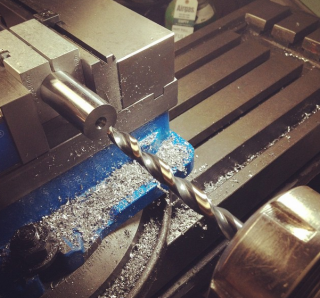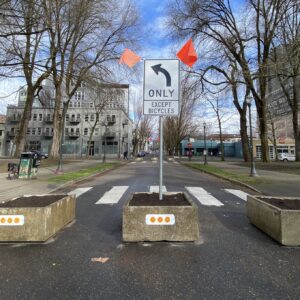Portland is thick with indie bike frame builders. But the most audacious bike-design entrepreneur in town is focused on everything except the frame.
Ringed on three and a half sides by his tiny metal fabrication studio — a sort of blue-collar cubicle inside ADX, Southeast Portland’s coworking facility for people who make stuff — David Lewis described the product he’s slowly trying to design from the gears out.
“It’s an American bicycle that’s affordable and ready to ride,” Lewis said. “I don’t know what that bike looks like yet.”
The 37-year-old founder of Veteran Bicycle Co. just got his machine manufacturing certificate this fall. But he’s about to head into his second year of trying to come up with completely new and lower-cost ways to design and manufacture any and every part of the bicycle.
It’s a process whose fundamentals were, he noted, invented almost 140 years ago.
“It was the 1880s, the boneshaker, I think,” said Lewis, who named his young bikebuilding startup after his 11-year career in the U.S. Army and Army Reserve. “Essentially, what we have today is the same thing. … You still sit on a bike with two wheels and a handlebar right here and steer the same way and pedal the same way. And nobody’s tried to challenge that yet.”
Lewis, born in Binghamton, N.Y., doesn’t see why that person shouldn’t be him.
Since leaving the military, Lewis has trained at Portland’s United Bicycle Institute and worked at Chris King Components. And though he might not end up rethinking the form of bikes entirely, he says his competitive advantage in his experiments is that the money in the bike industry remains focused on high-end solutions that prioritize performance over cost.
“What works in racing doesn’t work on a bike that’s cheap,” he explains. “We’re going through the process of reinvention right now for the drive train of a bicycle. … If you wanted to do anything else with gears, you’d have to buy these special things from Germany called a Pinion gear. That’s great and all for enthusiasts but there’s no way that the normal person can afford that.”
It’s just an example. But he’s thinking about ways to use axle widths, dropout spacing or integrating hub bearings into the frame as ways to “liberate bicycle drivetrain design and construction from what I feel is the dead weight of the derailleur.”
Advertisement
And he’s also searching for procedural simplifications such as, he says, “replacing traditional silver-brazing of cable guides and bottle bosses with a less expensive alternative using silicon bronze and a TIG torch. This also eliminates the need to rinse flux out of the joint with water, saving a step and also preventing a source of rust.”
His long-term goal is to work out a manufacturing process that would let him personally build 30 bikes per month while keeping his labor costs to $100 per frame. The bikes might retail in the $500 to $600 range and include accessories.
Other low-cost manufacturers, Lewis said, are “trying to sell you a $500 bike that’s really an $800 bike in disguise.”
“What’s happening now is conventional wisdom: import the bike and then sell a bunch of crap to the people who buy it — I don’t like that,” he said. “I want to make bikes that are ready to ride as soon as the person buys it. It’s got fenders for they can ride in any whether. It’s got lights. That’s not optional. It’s got a bell. It’s got a way to carry stuff.”
Though he has no apparent ambition of great wealth, Lewis is ambitious about bringing new ideas into bikemaking.
“I’m not necessarily a homebrewer who wants to be a craft brewer,” he says, referring to Portland’s bike-building scene. “I want to be a responsible Budweiser.”
To that end, he’s been saving cash and gathering skills as part of a Mercy Corps Northwest program that will give him a micro-grant at the end of this year. He plans to use it to buy a lathe and start manufacturing his first product: dummy axles.
“For shops, they are a commodity item that there are never enough of, and for consumers it will function as a shipping plug to protect dropout spacing during shipping frames for touring,” Lewis said. “My versions will be made of hardened tool steel and should last forever.”
Lewis, a bike user since his days as a paperboy, says he’s “not a salesman.” But he’s determined to find a way to bring his unorthodox ideas about bike manufacturing to market.
“I’m in the middle of trying to figure out how to turn this into a viable business,” he said, leaning over his workbench. “But I don’t give up, that’s for damn sure.”
Correction 11/14: A previous version of this post incorrectly described Lewis’s ideas about metal joining and drive trains.








Thanks for reading.
BikePortland has served this community with independent community journalism since 2005. We rely on subscriptions from readers like you to survive. Your financial support is vital in keeping this valuable resource alive and well.
Please subscribe today to strengthen and expand our work.
So, the goal is to beat China in the cheap bike game? That is a tall order. I would suggest looking at other materials besides metal to build this bike.
It’s definitely a tall order. Lewis says he’s deliberately not trying to compete with China on price; rather he said he’s trying to create an 100% American bike (including components and so forth). He bristles at bikes that brand themselves as “American” because they were brazed, painted and assembled here from Italian tubes and Chinese accessories.
I wouldn’t say that… I’ve seen some crazy ways to steer on pedal bikes throughout the years… the current design is just the easiest… it’s been challenged but nothing has worked well enough to make it into the mainstream…
If he’s going to revolutionize drivetrains, maybe he could create a derailleur bike that comes with a chaingaurd or, better yet, a full chain case.
Yeah, keep cranking on that idea-maker!
The hardened tool steel dummy axle doesn’t sound like a promising first product.
Right? I’m not sure why this couldn’t be abs. If it has to be metal, there are certainly cheaper materials and processes than lathe turned tool steel.
That said, the notion that lights aren’t an option on a bike is a nice change of pace. I’ve yet to understand why we don’t hold bicycles to the same light requirements of other vehicles, particularly with led cutting weight and bumping reliability/output.
Explain that “cheap” has the negative connotation of bad quality while “less expensive” or “more affordable” simply means “costs less”.
Worst time to use unfortunate marketing verbiage is at the beginning.
He has clearly already mastered handlebar technology [rimshot]. Thanks very much, I’ll be here all week.
Whatever you do, don’t do anything to make the bike look or sound like a Specialized. They got out of the bike business long ago to become masters of litigation.
Good for you David. Keep at it and good luck with your venture!
Mr. Lewis–remember to make it serviceable with normal, standard repair parts. A bike that’s inexpensive to buy can become expensive to own and fix. Methinks you should spend a few years really learning to assemble and repair bikes–five or ten years in a regular bike shop would give you an actual knowledge base for what works over the long haul. No apology here–I have worked in this business a long time and seen too many “innovations” that are frauds in disguise or designed in a basis of ignorance. Learn about what you’re talking about making before you start making ’em, okay?
Oh, and no charge for this design advice: a cheap grade of aluminum that regular 9 or 10mm axles can fit through will be more than good enough for travel axles!
I sincerely wish him all the best. But I worked in bike shops for many years. Hardly ever needed a “dummy axle” and when I did, I used one of the plastic shipping thingies that came on the new bikes we received or an old hub from the copious parts box. I suppose it’s different for frame-builders, though.
Lewis may have a bit of a wacky-scientist thing going, but you can’t fault a man for his idealistic vision. While in pursuit of his goals he will face a number of massive challenges, many of which have been mentioned in the comments above. But don’t think for a minute that those comments here will stop someone with a vision like his. His end products may look very different than he envisions them now, and his ideals may change over time, but perhaps they won’t.
I’ll never understood why people impose their own mental confinements on others. Your opinions here have nothing to do with the potential success or failure of a business like this. You simply can’t imagine, in the world you live in, that something like this is possible. Why not stand back for once, and let someone else show you what is possible? Wouldn’t you be pleasantly surprised for once when someone takes your mental confinements, and completely obliterates them?
I look forward to seeing that.
“Your opinions here have nothing to do with the potential success or failure of a business like this.”
I’m assuming he wants people to buy things from him at some point.
Mr. Lewis needs to learn enough about bikes as they are to realize that there is quite a lot right about them, probably more so than what is wrong with the current product.
Which manufacturing process is 140 years old? Robotic tig welding? Multi-directional carbon fiber layup? People have brazed, bonded, and welded bikes out of steel, aluminum, magnesium, carbon, bamboo, wood, cardboard, fiberglass, and who knows what, using techniques from homespun to high-tech. I’m not saying there’s nothing new under the sun, or that we shouldn’t seek other materials and methods, but the story makes it sound like Lewis believes he’s rescuing a hidebound industry from its lack of vision. That doesn’t seem likely from someone who worked for Chris King, so I hope it’s a shortcoming of the post.
Likewise, there are many options for people looking for bikes fully equipped with fenders, racks, and dynamo lighting systems. Joe Breeze led the way more than a decade ago, and many major manufacturers have followed suit. Having worked at a Breezer dealer, my personal experience was that such bikes are a hard sell in this country, where consumers don’t seem able to resist the charms of less practical bikes, and they enjoy accessorizing. Again, I don’t think these are reasons for not pursuing such a noble goal, but it’s important to keep history in mind.
Like I said: he’s audacious.
“Proper bicycle mechanics should be doing major overhaul work and do technical repairs on things like suspension, but instead are occupied with changing tubes and making small adjustments on parts that really shouldn’t need it if they were designed to function properly in the first place. Maybe then the profession could pay a living wage and not be a job like it is now: a seasonal job like cashiers at Walmart.”
That’s universal of all of society though. Look at the fact that few people change their own oil for their cars. It’s more an issue of a little lack of knowledge and a whole lot of convenience, than an issue of poor design.
Thanks for the clarifications and additions, David.
is it possible to “upcycle” old steel frames? cut the main tubes at the lug or junction point and reuse them? and maybe use different lug lengths to accomodate different sized tubes. shorter ones for large size frames and larger ones for smaller frames. i dunno. i think if he could offer a complete, made in the USA single speed but 600, people would definitely buy it. upcycle the frame and save some dough. rough sand it to get out rust and then clear coat it only. kind of a rat rod look but still protected from rust……
City bikes are already manufactured every day in America that cost roughly between $300~600 USD Retail.
Worksman Cycles is located in Ozone Park, Queens, New York City.
Cost of living there is significantly higher then in most of Oregon.
Here is a PDF of their facility –
http://www.worksmancycles.com/shopsite_sc/store/html/media/theworksmanfactory.pdf
Detroit Bikes has a USA Made City Bike that is an all Chromoly Frame with IGH Hub + a Rack & Fenders for $699 USD Retail.
LINK: http://detroitbikes.com/
The Cost of living there is slightly higher then most of Oregon.
Kent Bicycles just opened a totally new factory in South Carolina to assemble kids bikes costing less then $150 USD Retail.
Here is a NEWS Article –
http://www.postandcourier.com/article/20141014/PC1610/141019640
The Cost of living there is slightly higher then most of Oregon.
What Mr. Lewis is hoping to do is great, but thinking ‘outside the box’ is not really necessary to achieve his ultimate goal.
While there are improvements still possible to the manufacturing process, it is really important to understand that many people in the US are already successfully doing this every day.
David, I’ve had a difficult problem you may be the guy to solve. I’ve got a balloon. Just a normal balloon, and it’s tied to my wrist by a string. Same old ho-hum everyday string. One problem, among many, is all that helium right? It pulls up up up! Always with the up!!! And it hurts my wrist. And I was sitting there, in the park with my balloon cutting off the circulation to my gangrenous hand when it came to me- why not a string that used the balloons energy to dissipate not just upwards pull, but left right and maybe even down? There’s got to be a way. If only we can re-think the string. And I’m certain you’d be the gentleman for the job. Any ideas? My hand is just about to fall off here so, time is of the essence.
I’ve been going about this soloution the wrong way all along?! So- gravity. What can we do about gravity? How can it be stopped? It occurs to me that we’ve been living with the effects of gravity since…well for a long time now. Has nobody ever taken a second look at gravity? All it does is hold us down. When all we want is to be free. Free like the birds in a summer breeze. At the core of this problem, I guess, is a whole lot of molten iron. Specifically, at the earth’s core. If only there was a way we could tap that. Flip the poles and get this gravity thing to start working with us instead of against us all the time. Again, if you have any ideas, they sure would be helpful. This baloon isn’t getting any heavier.
It seems oddly uncharacteristic that you’d be a champion for the status quo. Even when it comes to gravity. Did I mention that my particular balloon is a beautiful balloon? It’s as if a bird of paradise were a balloon. Why would I hide that in a box? Hide it away from the world? If you saw a beautiful peacock, would you shame the beautiful peacock for it’s beautiful plumage? Would you put a sunset in a box, and hide it under a bed? Would you pull the curtains on a majestic mountain Vista? Getting back to topic, your solution does not address either the string, or gravity. We’re looking at two strikes here, and in the game of baseball you know what that means? That’s right: DANGER ZONE. Incidentally, ‘Danger Zone’ is Kenny Loggins most exciting hit. You know what isn’t exciting? Baseball, that’s what. Just bought this conversation full-circle there. Circle, like a balloon. Speaking of balloons, any solutions for that string problem of mine? I got one sooper dead hand now thanks to your lollygaggin’. But, the conundrum persists!
Youell have to excuse the mishtakes and typoo’s, as I am typping with just a left hand now (thanks a lot). I thought I was clear in requesting a string mechanism which lessened the harmful effects of upwiard-pulling balloon helioom. In the time I spent distracting the Pope from his busy job of being the best pope yet, to trying to untangle the zen notion of one-hand-clapping myself silly I could have spent at home watching Real Housewives of Atlanta since a local bike-builder friend of mine, he builds bicycle frames, suggested I just use some dang ribbon. Ribbon, it turns out, has both the tensile strength of string, is actually lighter than string and also comes in a variety of sparkly colors that add to the overall majesty of my balloon package. Took it from a solid ten, aaaaall the way up to eleven. Now, my balloon rocks almost as hard as the Clash. Greatest punk band evar. So, in conclusion: industry wins again. Children win. Children who, unlike me, get to run free without the danger of handloss. I’m sorry if I sound bitter but, I should have trusted this one to the people with solutions. Unless, and I’m going out on a stump here, you’re on the cuff of turning the prosthetics industry on its head? And I know you’re an army guy, at long last we all know you’re an army guy, so don’t go suggesting I fix a howitzer to the end of my wrist. I still have a social life to consider. There, against my better judgement, the gauntlet has been laid down. Note: by gauntlet I am not suggesting we replacing my dead hand with a gauntlet.
Side note, you’ve made some grave historical errors I was too polite to point out until now. George Washington’s teeth were not wooden as much as they were hand crafted gold fronts. That’s why everyone refers to him as our first Gangsta President. And the Wright brothers are still very much alive and are co-owners of a Best Western outside of Uma Arizona. Take my suggestion, from one bicyclist to a motorcyclist, if you’re going to talk out of school, you do some homework first.
Well, this sounds good to me! The worst that can happen is it won’t work out and I probably won’t hear about it again. The best that can happen is in a while I’ll be riding a Veteran around town, wondering if I can sell my other bikes on CL. More people trying to improve cycling is a win for everyone. I don’t know why so many people here think they know something Mr. Lewis doesn’t. Anyway, I’ll be keeping an eye out for good stuff to come.